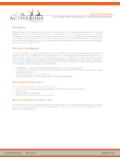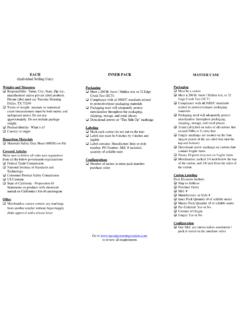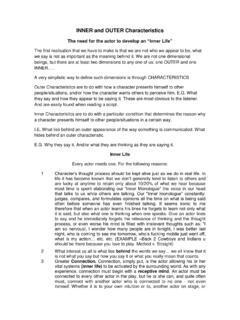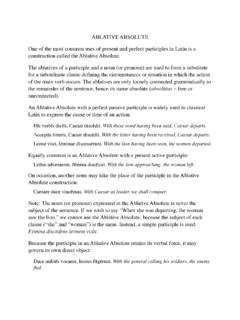Transcription of Personality Types - Inner City Books / Jung at Heart
1 Personality Types Marie-Louise von Franz, Honorary Patron Studies in Jungian Psychology by Jungian Analysts Daryl Sharp, General Editor Personality Types Jung s Model of Typology DARYL SHARP To my mother and father and to Vicki and Jessy Appendix 2, "The Clinical Significance of Extraversion and Introversion," by Fierz, , is reproduced here by permission of Antoinette Fierz of Zurich and Daimon Verlag of Einsiedeln, Switzerland, publisher of the late Dr. Fierz's papers. Canadian Cataloguing in Publication Data Sharp, Daryl, 1936- Personality Types : Jung s model of typology (Studies in Jungian psychology by Jungian analysts; 31) Includes bibliographical references and index.
2 ISBN 978-0-919123-30-4 1. Personality . 2. Typology (Psychology). 3. Jung, (Carl Gustav), 1875-1961. I. Title. II. Series. 1987 '64 C87-095102-5 Copyright 1987 by Daryl Sharp. All rights reserved. Inner CITY Books Box 1271, Station Q, Toronto, ON M4T 2P4, Canada Telephone (416) 927-0355 / Fax (416) 924-1814 Toll-free (US & Canada): 1-888-927-0355 / Fax 1-888-924-1814 Web site: / E-mail: Honorary Patron: Marie-Louise von Franz. Publisher and General Editor: Daryl Sharp. Senior Editor: Victoria Cowan. Office Manager: Scott Milligen Inner CITY Books was founded in 1980 to promote the understanding and practical application of the work of Jung.
3 Cover collage by Jessy Kate Cowan-Sharp. Printed and bound in Canada by Thistle Printing Company Ltd. CONTENTS Preface 9 1 Introduction to Jungian Typology 11 The Basic Model 12 Rational and Irrational Functions 16 The Primary Function and Auxiliary Functions 18 The Inferior Function 21 The Two Attitude Types 25 The Role of the Unconscious 32 Caveat to the Reader 34 2 Extraversion and the Four Functions 37 The Extraverted Attitude 37 The Extraverted Thinking Type 44 The Extraverted Feeling Type 49 The Extraverted Sensation Type 54 The Extraverted Intuitive Type 58 3 Introversion and the Four Functions 65 The Introverted Attitude 65 The Introverted Thinking Type 70 The Introverted Feeling Type 75 The Introverted
4 Sensation Type 79 The Introverted Intuitive Type 84 4 Concluding Remarks 89 Why Typology? 89 Type Testing 92 Typology and the Shadow 94 Appendix 1: The Clinical Significance of Extraversion and Introversion, by Fierz, 101 Appendix 2: A Dinner Party with the Types 113 Index 120 See final pages for other Inner City Books PAGE 6 - BLANK Classification does not explain the individual psyche. Nevertheless, an understanding of psychological Types opens the way to a better understanding of human psychology in general. Jung. PAGE 8 BLANK 9 Preface This book is not a critique or a defense of the model of psy-chological Types elaborated by Jung, but rather an expla-nation.
5 The intention here is not to simplify his model, but to illustrate its complexity and some of its practical implications. Jung's model of typology is not a system of character analysis, nor is it a way of labeling oneself or others. Much as one might use a compass to determine where one is in the physical world, Jung's typology is a tool for psychological orientation. It is a way of understanding both oneself and the interpersonal difficulties that arise between people. Other Books have been written based on Jung's system of psychological Types . If there is anything distinctive about this one, it is its close adherence to Jung's expressed views.
6 Jung in 1959, at the age of 84. 11 1 Introduction to Jungian Typology The experience that not everyone functions in the same way has been the basis for numerous systems of typology. From earliest times attempts have been made to categorize individu-al attitudes and behavior patterns, in order to explain the dif-ferences between people. The oldest system of typology known to us is the one de-vised by oriental astrologers. They classified character in terms of four trigons, corresponding to the four elements water, air, earth and fire. The air trigon in the horoscope, for instance, consists of the three aerial signs of the zodiac, Aquarius, Gemini, Libra; the fire trigon is made up of Aries, Leo and Sagittarius.
7 According to this age-old view, whoever is born under these signs shares in their aerial or fiery nature and has a corresponding temperament and fate; similarly for the water and earth signs. This system survives in modified form in present-day astrology. Closely connected with this ancient cosmological scheme is the physiological typology of Greek medicine, according to which individuals were classified as phlegmatic, sanguine, choleric or melancholic, based on the designations for the se-cretions of the body (phlegm, blood, yellow bile and black bile). These descriptions are still in common linguistic use, though medically they have long since been superseded.
8 Jung's own model of typology grew out of an extensive his-torical review of the type question in literature, mythology, aesthetics, philosophy and psychopathology. In the preface to Psychological Types , which contains his scholarly research and a detailed summary of his conclusions, he writes: 12 Introduction to Jungian Typology This book is the fruit of nearly twenty years' work in the do-main of practical psychology. It grew gradually in my thoughts, taking shape from the countless impressions and ex-periences of a psychiatrist in the treatment of nervous ill-nesses, from intercourse with men and women of all social levels, from my personal dealings with friend and foe alike, and, finally, from a critique of my own psychological The Basic Model Whereas the earlier classifications were based on observations of temperamental or emotional behavior patterns.
9 Jung's model is concerned with the movement of psychic energy and the way in which one habitually or preferentially orients one-self in the world. From this point of view, Jung differentiates eight typo-logical groups: two Personality attitudes introversion and extraversion and four functions or modes of orientation thinking, sensation, intuition and feeling each of which may operate in an introverted or extraverted way. The resulting eight variations will be examined in later chapters, with detailed descriptions of how each of the func-tions appears in combination with either the extraverted or in-troverted attitude.
10 What follows here is a brief explanation of the terms Jung used. Although introversion and extraversion have become household words, their meaning is frequently misunderstood; the four functions are not so widely known, and even less understood. Introversion and extraversion are psychological modes of 1 Psychological Types , CW 6, p. xi. [CW refers throughout to The Col-lected Works of Jung (Bollingen Series XX), 20 vols., trans. Hull, ed. H. Read, M. Fordham, G. Adler, Wm. McGuire; Princeton: Princeton University Press, 1953-1979.]









